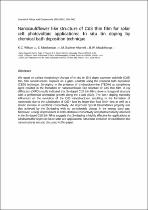 ResearchSpace
ResearchSpace
Nanocauliflower like structure of CdS thin film for solar cell photovoltaic applications: Insitu tin doping by chemical bath deposition technique
JavaScript is disabled for your browser. Some features of this site may not work without it.
- ResearchSpace
- →
- Research Publications/Outputs
- →
- Journal Articles
- →
- View Item
| dc.contributor.author |
Wilson, KC

|
|
| dc.contributor.author |
Manikandan, E

|
|
| dc.contributor.author |
Basheer Ahamed, M

|
|
| dc.contributor.author |
Mwakikunga, Bonex W

|
|
| dc.date.accessioned | 2014-09-30T13:22:29Z | |
| dc.date.available | 2014-09-30T13:22:29Z | |
| dc.date.issued | 2014 | |
| dc.identifier.citation | Wilson, K.C, Manikandan, E, Basheer, Ahamed, M and Mwakikunga, B.W. 2014. Nanocauliflower like structure of CdS thin film for solar cell photovoltaic applications: In situ tin doping by chemical bath deposition technique. Journal of Alloys and Compounds, vol. 585, pp 555-560 | en_US |
| dc.identifier.issn | 0925-8388 | |
| dc.identifier.uri | http://ac.els-cdn.com/S0925838813023591/1-s2.0-S0925838813023591-main.pdf?_tid=b8238b82-425c-11e4-9e20-00000aab0f27&acdnat=1411392852_38ba9e4a19e65ff54901253025a73c85 | |
| dc.identifier.uri | http://hdl.handle.net/10204/7699 | |
| dc.identifier.uri | https://www.sciencedirect.com/science/article/pii/S0925838813023591 | |
| dc.identifier.uri | https://doi.org/10.1016/j.jallcom.2013.09.185 | |
| dc.description | Copyright: 2014 Elsevier. This is an ABSTRACT ONLY. The definitive version is published Journal of Alloys and Compounds, vol. 585, pp 555-560 | en_US |
| dc.description.abstract | We report on surface morphology changes of in situ tin (Sn) doped cadmium sulphide (CdS) thin film nanostructures prepared on a glass substrate using the chemical bath deposition (CBD) technique. Sn-doping in the presence of triethanolammine (TEOA) as complexing agent resulted in the formation of nanocauliflower like structure of CdS thin film. X-ray diffraction (XRD) results indicated that Sn-doped CdS thin films show a hexagonal structure with a preferential orientation growth along the c-axis (002). The Sn(sup4+) doping markedly influenced on the evolution of the CdS nanostructures, resulting in the formation of nanocracks due to the substitution of Cd(sup2+) ions by larger-than-host Sn(sup4+) ions as well as a drastic increase in electrical conductivity. An improved optical transmittance property was also achieved by the Sn-doping with no considerable change in the energy band gap. Moreover, a large improvement in both electrical conductivity and photosensitivity observed in the Sn-doped CdS thin films suggests that Sn-doping is highly effective for applications as window/buffer layers in future solar cell applications. Structural evolution of cauliflower like nanostructures are also discussed in this paper. | en_US |
| dc.language.iso | en | en_US |
| dc.publisher | Elsevier | en_US |
| dc.relation.ispartofseries | Workflow;13362 | |
| dc.subject | Semiconductors | en_US |
| dc.subject | Thin films | en_US |
| dc.subject | Nanostructured materials | en_US |
| dc.subject | Scanning Electron Microscopy | en_US |
| dc.subject | SEM | en_US |
| dc.subject | X-ray diffraction | en_US |
| dc.subject | Electronic properties | en_US |
| dc.title | Nanocauliflower like structure of CdS thin film for solar cell photovoltaic applications: Insitu tin doping by chemical bath deposition technique | en_US |
| dc.type | Article | en_US |
| dc.identifier.apacitation | Wilson, K., Manikandan, E., Basheer Ahamed, M., & Mwakikunga, B. W. (2014). Nanocauliflower like structure of CdS thin film for solar cell photovoltaic applications: Insitu tin doping by chemical bath deposition technique. http://hdl.handle.net/10204/7699 | en_ZA |
| dc.identifier.chicagocitation | Wilson, KC, E Manikandan, M Basheer Ahamed, and Bonex W Mwakikunga "Nanocauliflower like structure of CdS thin film for solar cell photovoltaic applications: Insitu tin doping by chemical bath deposition technique." (2014) http://hdl.handle.net/10204/7699 | en_ZA |
| dc.identifier.vancouvercitation | Wilson K, Manikandan E, Basheer Ahamed M, Mwakikunga BW. Nanocauliflower like structure of CdS thin film for solar cell photovoltaic applications: Insitu tin doping by chemical bath deposition technique. 2014; http://hdl.handle.net/10204/7699. | en_ZA |
| dc.identifier.ris | TY - Article AU - Wilson, KC AU - Manikandan, E AU - Basheer Ahamed, M AU - Mwakikunga, Bonex W AB - We report on surface morphology changes of in situ tin (Sn) doped cadmium sulphide (CdS) thin film nanostructures prepared on a glass substrate using the chemical bath deposition (CBD) technique. Sn-doping in the presence of triethanolammine (TEOA) as complexing agent resulted in the formation of nanocauliflower like structure of CdS thin film. X-ray diffraction (XRD) results indicated that Sn-doped CdS thin films show a hexagonal structure with a preferential orientation growth along the c-axis (002). The Sn(sup4+) doping markedly influenced on the evolution of the CdS nanostructures, resulting in the formation of nanocracks due to the substitution of Cd(sup2+) ions by larger-than-host Sn(sup4+) ions as well as a drastic increase in electrical conductivity. An improved optical transmittance property was also achieved by the Sn-doping with no considerable change in the energy band gap. Moreover, a large improvement in both electrical conductivity and photosensitivity observed in the Sn-doped CdS thin films suggests that Sn-doping is highly effective for applications as window/buffer layers in future solar cell applications. Structural evolution of cauliflower like nanostructures are also discussed in this paper. DA - 2014 DB - ResearchSpace DP - CSIR KW - Semiconductors KW - Thin films KW - Nanostructured materials KW - Scanning Electron Microscopy KW - SEM KW - X-ray diffraction KW - Electronic properties LK - https://researchspace.csir.co.za PY - 2014 SM - 0925-8388 T1 - Nanocauliflower like structure of CdS thin film for solar cell photovoltaic applications: Insitu tin doping by chemical bath deposition technique TI - Nanocauliflower like structure of CdS thin film for solar cell photovoltaic applications: Insitu tin doping by chemical bath deposition technique UR - http://hdl.handle.net/10204/7699 ER - | en_ZA |





